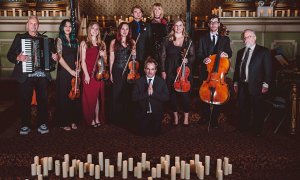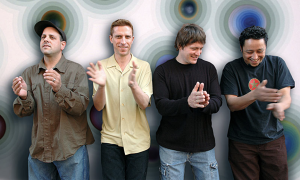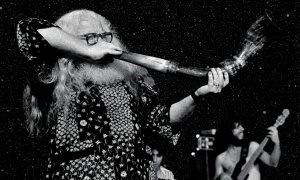Home » Jazz Articles » From the Inside Out » Soul Songs, Mose Songs & COVID Aid for Djibouti
Soul Songs, Mose Songs & COVID Aid for Djibouti

Courtesy Janto Djassi
 Bahama Soul Club
Bahama Soul ClubBohemia After Dawn
Buyú Records
2020
Soulful original music laced with judicious and striking samples, Bohemia After Dawn serves a textbook example of music that packs an impact larger than the sum of its parts. Written, arranged, produced and performed by Oliver Belz and André Neundorf (the Bahama Soul Club) plus guest musicians and singers live and looped, Bohemia After Dawn sets body, mind and soul to "simmer" from its opening "Afrodisia" through the end of its closing "Castelejo."
"Mango" slips and slides on its reggae beat while horns call and echo the melody in sweet and sticky scoops of sound. In the follow-up "Mango" (Club des Belugas Remix), a cool conga beat helps transports this reggae from the Caribbean to a nightclub in Brazil. "Alma Sola" walks along an ice-cold finger-snapping electric bass line with flute and purring female vocals drizzling sweet heat on top. Guitarists Ralli King and Bela Heine slice out soul-jazz blues chords and solos that feature touches of George Benson and Albert King to roll "Riding the Train" down the rails of a cool jazz guitar-organ combo sound.
Billie Holiday and John Lee Hooker (or at least their sampled voices) pop in as guest stars. Belz and Neundorf re-spin "Ain't Nobody's Business" around loops of Holiday's vocal, shaping the creeping shadow and darkness of Ray Manzarek's "Riders on the Storm" keyboard sound around the rhythms of Holiday's exquisite blues and punching out her words with the chorus horns.
In "Never Roam No More," the producers fold the gravelly growl and thunder of Hooker's inimitable voice into an improbable yet magical, thick and vibrant dance groove as smooth and cool as satin bedding. The SMOOVE Remix adds a full minute of extra music plus a whole lot of additional rhythm: a two-step drum kick, the synthetic disco pulse, and bass and guitar tweaked into Chic dancefloor funk, all sparkling in a slick Hamilton Bohannon-style mix. (I had to take review notes for this track three different times because the first two I wouldn't [or couldn't] stop dancing.)
The closing "Castelejo (Hommage à Vitor Hugo)" opens like a large jungle cat slowly waking, yawning, stretching, and then unraveling into a prowling instrumental, sounding thick and sparse, and creating moods both powerful and subdued.
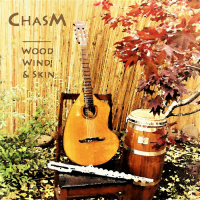 Chasm
ChasmWood Wind & Skin
Sticks & Stones Music
2020
When Mark Esakoff and Michael Whipple began collaborating in 1987, they focused their sound on the resonance of three sources: Wood (claves, marimbas, etc.), wind (flute, recorder, etc.) and skin (nylon strings, congas, etc.). Although their first four releases expanded their sound into metallic, electronic and other timbres, this fifth release honors the Wood, Wind & Skin purity of their early founding days.
In Chasm, Esakoff's primary voices are nylon string guitar and marimba (which he professes to play like a "log drum piano"), and Whipple's are flute, keyboards and drums. Whipple also plays bass and percussion and sings on Wood, Wind & Skin, while Esakoff adds luitars (lute-guitars), ukuleles, bass and vocals.
Esakoff and Whipple are both natives of Ventura (California). This might not at first seem relevant, but if you've hiked through sunlit mountains, there's a good chance you'll recognize the sound, vision and (especially) the feel of Wood, Wind & Skin. After the reverential two-minute introduction "Praying for Rain," the music skips easy and carefree into the warm "Sideways Sunshine" and then tumbles into the bright and pretty "Look at Her Glow."
"Arctic Crossing" turns much more cold and brittle and seems to float frozen in space, suspended by arching strings, until quick and sharp guitar notes pierce its static sound like icy needles of frozen rain. "Inner Jungle" turns even darker and more mysterious: A cymbal keeps anxious time while percussion slithers and rattles out from shadows and bass builds a Middle Eastern mood, then a solitary horn rises up like Yusef Lateef to scan the horizon for eastern sounds and leading the music into a whirling Arabic dance.
It's surprising to find a tune by heavy metal monster gods Black Sabbath in the midst of such sweetness and light, but Chasm find and magnify the beauty in "Laguna Sunrise," a melodic pause co-written by all four Sabbath members for their sprawling 1972 double-vinyl Vol. 4. It's a great reminder of how the gentleness and simplicity of Wood, Wind & Skin almost disguises the instrumental dexterity and profound connection between Mark Esakoff and Michael Whipple. Almost disguises, but not quite.
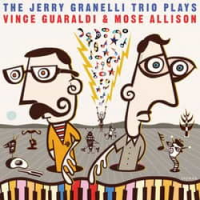 Jerry Granelli
Jerry GranelliPlays Vince Guaraldi & Mose Allison
RareNoise Records
2020
Drummer Jerry Granelli, bassist Brad Jones and pianist Jamie Saft team in a trio that Plays Vince Guaraldi & Mose Allison to honor two of the most influentially lyrical and bluesy composer-musicians in jazz history.
Granelli possesses deep personal insight into both principals. He landed in the drum chair in Vince Guaraldi's trio just as the title track to the pianist's 1962 landmark Cast Your Fate to the Wind was breaking out in the US singles charts and remained for three momentous years, contributing to Guaraldi's celebrated early Peanuts television specials and recordings with Brazilian guitarist Bola Sete.
Granelli subsequently served for nearly four decades as Mose Allison's drummer, jumping in to help the blues buddha record his landmark Your Mind is On Vacation (1976, Atlantic) and providing the steady heartbeat for Allison's blues musing until the composer passed in 2016. "Mose was like the Charles Ives of the blues," Granelli recalls. "He would take the blues as far out as he could, and he became one of the great influences in American songwriting.
"We all love the blues, whether we play them all the time or not, and we all love great songs—and these are really great songs."
It's simply remarkable that even just the opening notes to "Cast Your Fate" still cast such a haunting and evocative spell, more than merely beautiful, with Granelli, Jones and Saft all finding new pictures to paint in Guaraldi's familiar colors.
Then this set turns most thoroughly and magically blue. The trio stretches "Parchman Farm" across eight skintight minutes, their roaring musical monster eventually growing three distinct instrumental heads: Jones' bass throbbing like a blues toothache, Granelli's bass and snare drums treacherously bombing the beat, and Saft dropping in familiar blues lines and shapes but not in the places or times you're used to hearing them, splattering blue color and sound like an impressionist Ramsey Lewis. Saft and Granelli especially bootstomp through "Your Mind is on Vacation," too, with Saft slamming chords out so hard they seem to turn brittle and shatter off the black and white ivories, and Granelli laying just behind the beat to rock a funky, almost boogaloo, sound. "Parchman Farm" and "Vacation" rock hard but they're nowhere near rock 'n' roll.
Saft softly steers "Star Song" to the edge of Bill Evans' kaleidoscopic and reflective sound, copping nods to "Moon River" and "The Christmas Song" along his way while the rhythm section swings it like a jazz samba. This set ends with the bright and childlike strains of "Christmas Time is Here" ringing deliciously in your ears.
A lot of music that comes out on the Rare Noise label can go over my head in concept or sound, but Plays Vince Guaraldi & Mose Allison lands squarely in my mind and heart.
 Groupe RTD
Groupe RTDThe Dancing Devils of Djibouti
Ostinato Records
2020
A historic cultural achievement, The Dancing Devils of Djibouti celebrates the first recording to emerge with international distribution from the East African nation of Djibouti.
Djibouti, among the smallest and youngest nations of Africa, sits on the historic Bab El Mandeb (Gate of Tears) strait, a global trade corridor that connects the Indian Ocean with the Red Sea and Suez Canal. Through this geography, the native Afar and Somali music of Djibouti washes in musical streams originating in East Asia, the Arabian peninsula, India and other distant places.
The Dancing Devils captures the first studio recording by Djibouti's national ceremony musical ensemble Groupe RTD, which performs for national events by day but unleashes their own joyous music when they're off the state clock. Led by guitarist Abdirazak Hagi Sufi and Mohamed Abdi Alto (a saxophonist so talented that he adopted his instrument into his legal name), Groupe RTD describe their sound as the meeting of Jamaican dub and reggae, more subtle African rhythms, sleek American jazz horns, and singalong synthesizer melodies, led by reggae toasting and Bollywood-style male and female vocals.
This recording fits the bustling dynamics and colors of that description. "Buuraha U Dheer (The Highest Mountains)" and "Raga Kaan Ka'Eegtow (You Are the One I Love)" feature female vocalist Asma Omar, who then drops back to duet and support male vocalist Hassan Omar Houssein through the rest of the set. These first two tunes— with bubbling reggae basslines, communal African rhythms and grooves and celebratory lead vocals, all wrapped up in the majestic colors of India and Africa plus a delightful Arabian wiggle—absolutely explode out of this production.
"Suuban (Joy)" is smartly titled, with Houssein's voice tying together the call and response between the rhythm and melody instruments that keep this powerful music rolling like a strong and implacable river. "Wiil Wille (The Jumping Man)" ends the set with vocals and drums that march Groupe RTD off to fight another day.
The COVID pandemic has been particularly hard on Djibouti and other African nations. A portion of Bandcamp sales is donated in equal parts to the Djiboutian Embassy in Germany to purchase masks and other essential supplies for Djibouti, and to the Amref Health Africa COVID-19 Fund.
 Purdie Fabian Oswanski
Purdie Fabian OswanskiMove On!
Consolidated Artist Productions
2020
In a 1977 magazine interview, New York Yankees Hall of Famer Reggie Jackson (in)famously referred to himself as "the straw that stirs the drink" for his team. On this trio set with organ player and composer Ron Oswanski and bassist-composer Christian Fabian (who also shaped the arrangements), the one and only original funky drummer Bernard Purdie keeps stirring his drum pots to help this trio's funky and rhythmic grooves Move On!
The leadoff "The Red Plaza" and subsequent "BPP Blues" (referencing the famous Bernard "Pretty" Purdie nickname) immediately reveal this set's heart and soul: It's the sound of sheer musical joy. Purdie stretches out and snaps back the beat as he strolls through "The Red Plaza," while bassist Fabian fingerpops some funk and Oswanski keeps pace by playing soul with the fever and speed of rock 'n' roll.
Fabian's arrangement neatly keeps "Can't You See (You're Doin' Me Wrong)" from Tower of Power's Back to Oakland (1975, Warner Bros.) as a soul ballad, his bass singing the melody in a wonderfully conversational tone with keyboards singing harmony and support vocals. They also render Duke Ellington's "Love You Madly" with a loving touch.
The last three tunes close Move On! with howling hurricane force. Fabian's tight New Orleans bass line, twist-tied to Purdie's rollicking drumbeat, provides the straw that stirs the title track. The trio completely blows up the 160-year-old warhorse "The Battle Hymn of the Republic" into a free and easy jam that you might hear rising out of some smokey little speakeasy late on a Saturday night, much more fun and playful than you'd reasonably expect.
Oswanski stretches out Miles Davis' "So What" into the electric spaciousness of Brian Auger and his fusion-fueled Oblivion Express but without leaving the gritty soul and feel of blues and rock keyboards behind, with Fabian's bass calling out that famous original bass line and Oswanski's keyboards simulating the horns echoing back that blue response. It's a great way to close Move On!: Leaving you wanting to hear just one more tune.
 Various Artists
Various ArtistsNew Orleans Mambo: Cuba to NOLA
Putumayo Records
2020
The distance between New Orleans (Louisiana, USA) and Havana (Cuba) is almost exactly 670 miles, about a two-hour flight. But it takes only one listen to Putumayo Records' anthology New Orleans Mambo: Cuba to NOLA to bridge the distance between the two.
With such a wide and colorful net to cast, assembling this collection must have been a lot of fun. This includes the companion booklet, which contextualizes the cross-cultural dance between New Orleans and Cuba by quoting New Orleans jazz pioneer Jelly Roll Morton on the Latin influence in jazz: "If you can't manage to put tinges of Spanish in your tunes, you will never be able to get the right seasoning for jazz."
Cuba to NOLA starts with Poncho Sanchez's Afro-Cuban joyride through "Going Back to New Orleans," using harmonica to underline the blues sound in the horn chart, and congas to slip that Afro-Cuban headbob into its New Orleans swing. ("Going Back" was Joe Liggins & The Honeydrippers' breakout 1952 single on New Orleans' hometown label Specialty Records.) It ends with the groaning New Orleans horns and Afro-Cuban rhythms of the Preservation Hall Jazz Band's "Kreyol" song, the ensemble's compositional keepsake from their 2015 journey to Cuba.
There are wonderful sights and sounds from Cuba to NOLA in between. You'd be hard pressed to find three minutes that represent New Orleans better than "Mos' Scocious," with piano and vocals by Dr. John and The Meters as his rhythm section, produced by Allen Toussaint. Bass thumps out a rhythm line that a tuba would have played in earlier jazz generations, but doesn't lose one single precious drop of thick New Orleans funk in the instrumental transition.
One of the first families of New Orleans musical royalty, the Neville Brothers shimmer through the title track of Yellow Moon, haunted by brother Aaron's desperately emotive vocal—the panic of a man who just realized the woman he loves might already be gone.
But this update on "Jive Samba" by Los Po-Boy-Citos, whose very name Latin-izes a famous New Orleans sandwich, delivers this collection's biggest musical surprise and smiles. Their yummy triple-decker sandwiches the verses of Cannonball Adderley's original "Samba" into the gospel classic "Wade in the Water" and its chorus into Mongo Santamaria's "Watermelon Man." It's a lot of fun.
 Walter White
Walter WhiteBB XL
IFUNU Music
2020
Born in a musical family near Detroit and classically trained at Juilliard, trumpet and flugelhorn player Walter White keeps a hectic schedule as leader of Atlantic Bridge, the Walter White Jazz Quartet, Walter White & Small Medium @ Large, and of the fusion ensemble IFUNU; as a member of the Beige Trio; and as lead trumpet for the Manhattan Jazz Orchestra directed by David Matthews. White has also served as Virtual Guest Artist-In-Residence for the Rutgers University Jazz Program directed by Conrad Herwig and has previously worked with the Detroit Symphony Orchestra, the Lincoln Center Jazz Orchestra with Wynton Marsalis, the Woody Herman Orchestra and the Mingus Big Band.
A stellar collection of covers, originals and crackerjack musicians, BB XL provides extra-large helpings of White's horns in a big jazz sound, and he takes advantage of every opportunity to blow out his chops. It opens with a journey across "Atlantic Bridge" that seems to rise "Up, Up and Away" with a lovely floating feeling; piano and winds twirl in counterpoint to the luxuriantly bright, glowing brass, and the band tosses the melody across different sections of the band like a celebratory toast.
White strings classic jazz and ballad covers together on BB XL like gorgeous pearls. His trumpet tap-dances as soft-but sure-footed as Fred Astaire on the melody to "The Way You Look Tonight," arranged as a jazz samba, and then sings out "My Foolish Heart" like a soul balladeer, two quick snapshots of this set's keen, bright and accessible sound.
White builds most of the rest of BB XL upon three enduring pillars of the jazz canon. This relaxed arrangement of "Cantaloupe Island" (Herbie Hancock) lets it drift off into a samba (or mambo), but spreads the call and response across different sections of the band to make sure it keeps moving.
Then the XL BB burns like fire through "Blue Rondo a la Turk" (Dave Brubeck) and "Nica's Dream" (Horace Silver). This arrangement of "Blue Rondo" was commissioned for the Detroit Jazz Festival's Tribute to Brubeck and was released to celebrate the one hundredth anniversary of the pianist's birth (December 6, 1920). White's trumpet skyrockets up and over "Nica's Dream" to pierce the sound of this eight-minute arrangement (originally written for Maynard Ferguson, with whom White performed and recorded in the early 1990s) with flaming arrows of high and hot notes. You simply must hear White's high register notes searing through both these tunes for yourself, to understand how magnificently accomplished, powerful, and stratospheric his trumpet sounds.
Tracks and Personnel
Bohemia After DawnTracks: Afrodisia; Ain't Nobody's Business (featuring Billie Holiday); Mercy Me (featuring Josephine Nightingale); Mango (featuring Arema Arega); Never Roam No More (featuring John Lee Hooker); Troubles All Be Gone (featuring Taly); Alma Sola (featuring Arema Arega); Riding The Train; Tears Run Down (featuring Sister Wynona Carr); Never Roam No More (SMOOVE Remix); Mango (Club des Belugas Remix); Castelejo (Hommage à Vitor Hugo).
Personnel: All tracks written and performed by Oliver Belz & André Neundorf with York: saxophones (Afrodisia), flutes (Troubles All Be Gone); Ralli King: guitar (Mercy Me, Riding the Train); Holger Stonjek: bass (Mercy Me, Troubles All Be Gone, Alma Sola, Riding the Train); Lars Lehmann: bass (Mercy Me); Maike Jacobs: backing vocals (Mercy Me); Claus Hartisch: guitar, bass (Mango); Bela Heine: guitar (Riding the Train); Vitor Hugo: cana rachada (Castelejo); Rui Correia: accordeon (Castelejo).
Wood Wind & Skin
Tracks: Praying for Rain; Sideways Sunshine; Look at Her Glow; Strange Currents; On a Lark; Mountains; Inner Jungle; Agua Blanca; The Memory Box; Laguna Sunrise; Element People; Arctic Crossing; The Silence Between the Words.
Personnel: Mark Esakoff: guitar, marimba, luitar, ukelele, bass, vocals; Michael Whipple: flute, keyboards, drums, percussion, vocals.
Plays Vince Guaraldi & Mose Allison
Tracks: Cast Your Fate to the Wind (Vince Guaraldi); Parchman Farm (Mose Allison); Baby Please Don't Go (Traditional); Mind (Prelude 1); Everybody's Cryin' Mercy (Mose Allison); Star Song (Mose Allison); Young Man Blues (Mose Allison); Mind (Prelude 2); Your Mind Is on Vacation (Mose Allison); Christmas Time Is Here (Vince Guaraldi / Lee Mendelson).
Personnel: Jerry Granelli: drums; Brad Jones: bass; Jamie Saft: piano.
The Dancing Devils of Djibouti
Tracks: Buuraha U Dheer (The Highest Mountains); Raga Kaan Ka'Eegtow (You Are the One I Love); Kuusha Caarey (The Pearl Necklace); Raani (Queen); Alto's Interlude; Uurkan Kaadonaya (I Want You); Halkaasad Dhigi Magtiisa (That's Where You'll Leave His Reward); Iiso Daymo (Look at Me); Suuban (Joy); Wiil Wille (The Jumping Man).
Personnel: Mohamed Abdi Alto: saxophone; Asma Omar: vocals; Guessod Abdo Hamargod: vocals; Hassan Omar Houssein: vocals; Omar Farah Houssein: drums; Moussa Aden Ainan: keyboards; Abdirazak Hagi Sufi "Kaajaa": guitar; Abdo Houssein Handeh: bass; Salem Mohamed Ahmed: dumbek.
Move On!
Tracks: The Red Plaza; BPP Blues; Can't You See (You're Doin' Me Wrong); 84-85; Got Groove (pt. 2); Love You Madly; Move On!; The Battle Hymn of the Republic; So What.
Personnel: Bernard Purdie: drums; Christian Fabian: bass, arrangements; Ron Oswanski: organ.
New Orleans Mambo: Cuba to NOLA
Tracks: Going Back To New Orleans (Poncho Sanchez); Mos' Scocious (Dr. John); Jive Samba (Los Po- Boy-Citos); Coconut Milk (Bo Dollis & The Wild Magnolias); Jambalaya (New Orleans Heartbreakers with Big Al Carson); Man?anita (Zazou City); Panama Tones / Nuevo Boogaloo (The Iguanas); Yellow Moon (The Neville Brothers); Nature Boy (Otra); Kreyol (Preservation Hall Jazz Band).
Personnel: Poncho Sanchez (Going Back To New Orleans); Dr. John (Mos' Scocious); Los Po-Boy-Citos (Jive Samba); Bo Dollis & The Wild Magnolias (Coconut Milk); New Orleans Heartbreakers with Big Al Carson (Jambalaya); Zazou City (Man?anita); The Iguanas (Panama Tones / Nuevo Boogaloo); The Neville Brothers (Yellow Moon); Otra (Nature Boy); Preservation Hall Jazz Band (Kreyol).
BB XL
Tracks: Atlantic Bridge; Blue Rondo a la Turk; Cantaloupe Island; Nica's Dream; Portus Apostoli (Intro); Portus Apostoli; The Way You Look Tonight; My Foolish Heart; Yo Conecto.
Personnel: Alex Foster: soprano sax, tenor sax; Ron Blake: alto sax, tenor sax; Steve Kenyon: baritone sax; Tristan Cappel: alto sax; Donell Snyder: tenor sax; baritone sax, soprano sax, alto sax; Keith Kaminski: alto sax, baritone sax, tenor sax; Conrad Herwig: trombone; Dave Mosko: trombone; Adam Machaskee: trombone; David Taylor: trombone; Altin Sencalar: trombone; Chris Glassman: trombone; Rob Killips: trombone; Don Anderson: tuba; Walter White: trumpets; Wayne Bergeron: trumpet; Ken Robinson: trumpet; Gary Schunk: piano; Ruben Rodriguez: bass; Jack Dryden: bass; James Simonson: bass; Jeff Trudell: drums; Graham Hawthorne: drums; Oscar Cruz: congas; Pablo Batista: percussion.
< Previous
Tom Kennedy: Stories From Behind and ...
Next >
Indaba Is
Comments
Tags
From the Inside Out
Chris M. Slawecki
Bahama Soul Club
Oliver Belz
André Neundorf
Ralli King
Bela Heine
george benson
albert king
Billie Holiday
John Lee Hooker
Ray Manzarek
Chic
Hamilton Bohannon
Vitor Hugo
Chasm
Mark Esakoff
Michael Whipple
Yusef Lateef
Black Sabbath
Jerry Granelli
Brad Jones
Jamie Saft
Vince Guaraldi
Bola Sete
Mose Allison
Ramsey Lewis
Bill Evans
Groupe RTD
Purdie Fabian Oswanski
Ron Oswanski
Christian Fabian
Bernard Purdie
Tower of Power
duke ellington
Miles Davis
Brian Auger
Oblivion Express
Various Artists
Jelly Roll Morton
Poncho Sanchez
Preservation Hall Jazz Band
Dr. John
The Meters
Allen Toussaint
Neville Brothers
Cannonball Adderley
Mongo Santamaria
Walter White
Atlantic Bridge
Walter White Jazz Quartet
Walter White & Small Medium @ Large
IFUNU
Beige Trio
Manhattan Jazz Orchestra
David Matthews
Conrad Herwig
Detroit Symphony Orchestra
Lincoln Center Jazz Orchestra
wynton marsalis
Woody Herman Orchestra
Mingus Big Band
Herbie Hancock
Dave Brubeck
Horace Silver
Maynard Ferguson
For the Love of Jazz
 All About Jazz has been a pillar of jazz since 1995, championing it as an art form and, more importantly, supporting the musicians who create it. Our enduring commitment has made "AAJ" one of the most culturally important websites of its kind, read by hundreds of thousands of fans, musicians and industry figures every month.
All About Jazz has been a pillar of jazz since 1995, championing it as an art form and, more importantly, supporting the musicians who create it. Our enduring commitment has made "AAJ" one of the most culturally important websites of its kind, read by hundreds of thousands of fans, musicians and industry figures every month.






